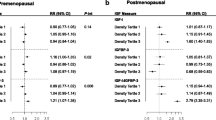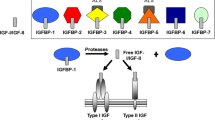Abstract
We investigated insulin-like growth factor (IGF)-1 and IGF binding protein (IGFBP)-3 concentrations in histologically normal breast tissues and assessed their association with plasma concentrations, and breast cancer risk factors. IGF-1 and IGFBP-3 were assessed in plasma and breast tissues of 90 women with no history of any cancer and undergoing reduction mammoplasty. Pearson correlations and ANOVAs were used to describe plasma-breast associations and biomarker differences by breast cancer risk factors, respectively. Multivariable regression models were used to determine associations between risk factors, and breast IGF-1 and IGFBP-3. The mean age of the study sample was 37.3 years, 58 % were white, and generally these women were obese (mean BMI = 30.8 kg/m2). We observed no plasma-breast correlation for IGF-1, IGFBP-3, or IGF-1/IGFBP-3 (r = −0.08, r = 0.14, and r = 0.03, respectively; p-values >0.05). Through age- and BMI-adjusted analysis, BMI and years of oral contraceptive (OC) use were inversely associated with breast IGF-1 (p-values = 0.02 and 0.003, respectively) and age was associated with breast IGFBP-3 (p = 0.01), while breast IGF-1/IGFBP-3 was higher in blacks than whites (1.08 vs. 0.68, p = 0.04) and associated with age and BMI (p-values = 0.03 and 0.002, respectively). In multivariable-adjusted models, some breast cancer risk factors studied herein explained 24, 10, and 15 % of the variation in breast IGF-1, IGFBP-3, and IGF-1/IGFBP-3, respectively. While reasons for the lack of plasma-breast hormone correlations in these cancer-free women are unknown, several factors were shown to be associated with breast concentrations. The lack of correlation between blood and tissue IGF-1 and IGFBP-3 suggests that studies of breast cancer risk assessing blood IGF-1 and IGFBP-3 may have important limitations in understanding their role in breast carcinogenesis.
Similar content being viewed by others
References
Kleinberg DL (1998) Role of IGF-I in normal mammary development. Breast Cancer Res Treat 47:201–208
Pollak MN (1998) Endocrine effects of IGF-I on normal and transformed breast epithelial cells: potential relevance to strategies for breast cancer treatment and prevention. Breast Cancer Res Treat 47:209–217
Moschos SJ, Mantzoros CS (2002) The role of the IGF system in cancer: from basic to clinical studies and clinical applications. Oncology 63:317–332
Sachdev D, Yee D (2001) The IGF system and breast cancer. Endocr Relat Cancer 8:197–209
Stewart CE, Rotwein P (1996) Growth, differentiation, and survival: multiple physiological functions for insulin-like growth factors. Physiol Rev 76:1005–1026
Nickerson T, Huynh H, Pollak M (1997) Insulin-like growth factor binding protein-3 induces apoptosis in MCF7 breast cancer cells. Biochem Biophys Res Commun 237:690–693
Jones JI, Clemmons DR (1995) Insulin-like growth factors and their binding proteins: biological actions. Endocr Rev 16(1):3–34
Ali O, Cohen P, Lee KW (2003) Epidemiology and biology of insulin-like growth factor binding protein-3 (IGFBP-3) as an anti-cancer molecule. Horm Metab Res 11–12:726–733
Clemmons DR (1997) Insulin-like growth factor binding proteins and their role in controlling IGF actions. Cytokine Growth Factor Rev 8:45–62
Key TJ, Appleby PN, Reeves GK, Roddam AW (2010) Insulin-like growth factor 1 (IGF1), IGF binding protein 3 (IGFBP3), and breast cancer risk: pooled individual data analysis of 17 prospective studies. Lancet oncol 11:530–542
Krajcik RA, Borofsky ND, Massardo S, Orentreich N (2002) Insulin-like growth factor I (IGF-I), IGF-binding proteins, and breast cancer. Cancer Epidemiol Biomarkers Prev 11:1566–1573
Rollison DE et al (2010) Serum insulin-like growth factor (IGF)-1 and IGF binding protein-3 in relation to breast cancer among Hispanic and white, non-Hispanic women in the US Southwest. Breast Cancer Res Treat 121:661–669
Toniolo P et al (2000) Serum insulin-like growth factor-I and breast cancer. Int J Cancer 88:828–832
Hankinson SE et al (1998) Circulating concentrations of insulin-like growth factor-I and risk of breast cancer. Lancet 351:1393–1396
Baglietto L et al (2007) Circulating insulin-like growth factor-I and binding protein-3 and the risk of breast cancer. Cancer Epidemiol Biomarkers Prev 16:763–768
Rinaldi S et al (2006) IGF-I, IGFBP-3 and breast cancer risk in women: the European Prospective Investigation into Cancer and Nutrition (EPIC). Endocr Relat Cancer 13:593–605
Allen NE et al (2003) Lifestyle determinants of serum insulin-like growth-factor-I (IGF-I), C-peptide and hormone binding protein levels in British women. Cancer Causes Control 14:65–74
DeLellis K et al (2004) Dietary and lifestyle correlates of plasma insulin-like growth factor-I (IGF-I) and IGF binding protein-3 (IGFBP-3): the multiethnic cohort. Cancer Epidemiol Biomarkers Prev 13:1444–1451
Fowke JH et al (2010) Racial differences in the association between body mass index and serum IGF1, IGF2, and IGFBP3. Endocr Relat Cancer 17:51–60
Jernstrom H et al (2001) Genetic and nongenetic factors associated with variation of plasma levels of insulin-like growth factor-I and insulin-like growth factor-binding protein-3 in healthy premenopausal women. Cancer Epidemiol Biomarkers Prev 10:377–384
Johansson H et al (2004) Factors associated with circulating levels of insulin-like growth factor-I and insulin-like growth factor binding protein-3 in 740 women at risk for breast cancer. Breast Cancer Res Treat 88:63–73
Lukanova A et al (2001) A cross-sectional study of IGF-I determinants in women. Eur J Cancer Prev 10:443–452
Morimoto LM, Newcomb PA, White E, Bigler J, Potter JD (2005) Variation in plasma insulin-like growth factor-1 and insulin-like growth factor binding protein-3: personal and lifestyle factors (United States). Cancer Causes Control 16:917–927
Diorio C, Brisson J, Berube S, Pollak M (2008) Intact and total insulin-like growth factor-binding protein-3 (IGFBP-3) levels in relation to breast cancer risk factors: a cross-sectional study. Breast Cancer Res 10:R42
DeLellis HendersonK et al (2007) Lifestyle and dietary correlates of plasma insulin-like growth factor binding protein-1 (IGFBP-1), leptin, and C-peptide: the Multiethnic Cohort. Nutr Cancer 58:136–145
Faupel-Badger JM, Berrigan D, Ballard-Barbash R, Potischman N (2009) Anthropometric correlates of insulin-like growth factor 1 (IGF-1) and IGF binding protein-3 (IGFBP-3) levels by race/ethnicity and gender. Ann Epidemiol 19:841–849
Llanos AA et al (2012) Adipokines in plasma and breast tissues: associations with breast cancer risk factors. Cancer Epidemiol Biomarkers Prev 21:1745–1755
Dumitrescu RG et al (2010) Familial and racial determinants of tumour suppressor genes promoter hypermethylation in breast tissues from healthy women. J Cell Mol Med 14:1468–1475
Allen NE et al (2005) A prospective study of serum insulin-like growth factor-I (IGF-I), IGF-II, IGF-binding protein-3 and breast cancer risk. Br J Cancer 92:1283–1287
Agurs-Collins T, Adams-Campbell LL, Kim KS, Cullen KJ (2000) Insulin-like growth factor-1 and breast cancer risk in postmenopausal African-American women. Cancer Detect Prev 24:199–206
Kahan Z et al (2006) Elevated levels of circulating insulin-like growth factor-I, IGF-binding globulin-3 and testosterone predict hormone-dependent breast cancer in postmenopausal women: a case-control study. Int J Oncol 29:193–200
Gunter MJ et al (2009) Insulin, insulin-like growth factor-I, and risk of breast cancer in postmenopausal women. J Natl Cancer Inst 101:48–60
Kaaks R et al (2002) Prospective study of IGF-I, IGF-binding proteins, and breast cancer risk, in northern and southern Sweden. Cancer Causes Control 13:307–316
Schairer CM, Isaacs C, Sue LY, Pollak MN, Berg CD, Ziegler RG (2010) Circulating insulin-like growth factor (IGF)-I and IGF binding protein (IGFBP)-3 levels and postmenopausal breast cancer risk in the prostate, lung, colorectal, and ovarian cancer screening trial (PLCO) Cohort. Horm Cancer 1:100–111
Schernhammer ES, Holly JM, Hunter DJ, Pollak MN, Hankinson SE (2006) Insulin-like growth factor-I, its binding proteins (IGFBP-1 and IGFBP-3), and growth hormone and breast cancer risk in The Nurses Health Study II. Endocr Relat Cancer 13:583–592
Schernhammer ES, Holly JM, Pollak MN, Hankinson SE (2005) Circulating levels of insulin-like growth factors, their binding proteins, and breast cancer risk. Cancer Epidemiol Biomarkers Prev 14:699–704
Falk RT et al (2012) Sex steroid hormone levels in breast adipose tissue and serum in postmenopausal women. Breast Cancer Res Treat 131:287–294
Rosen CJ (1999) Serum insulin-like growth factors and insulin-like growth factor-binding proteins: clinical implications. Clin Chem 45:1384–1390
Figueroa JA, Jackson JG, McGuire WL, Krywicki RF, Yee D (1993) Expression of insulin-like growth factor binding proteins in human breast cancer correlates with estrogen receptor status. J Cell Biochem 52:196–205
Jernstrom H, Olsson H (1994) Suppression of plasma insulin-like growth factor-1 levels in healthy, nulliparous, young women using low dose oral contraceptives. Gynecol Obstet Invest 38:261–265
Rosenberg L, Boggs DA, Wise LA, Adams-Campbell LL, Palmer JR (2010) Oral contraceptive use and estrogen/progesterone receptor-negative breast cancer among African American women. Cancer Epidemiol Biomarkers Prev 19:2073–2079
Rosenberg L, Zhang Y, Coogan PF, Strom BL, Palmer JR (2009) A case-control study of oral contraceptive use and incident breast cancer. Am J Epidemiol 169:473–479
Urban M et al (2012) Injectable and oral contraceptive use and cancers of the breast, cervix, ovary, and endometrium in black South african women: case-control study. PLoS Med 9:e1001182
Berrigan D et al (2009) Race/ethnic variation in serum levels of IGF-I and IGFBP-3 in US adults. Growth Horm IGF Res 19:146–155
Pinheiro SP, Holmes MD, Pollak MN, Barbieri RL, Hankinson SE (2005) Racial differences in premenopausal endogenous hormones. Cancer Epidemiol Biomarkers Prev 14:2147–2153
Morris GJ, Mitchell EP (2008) Higher incidence of aggressive breast cancers in African-American women: a review. J Natl Med Assoc 100:698–702
Rose DP, Royak-Schaler R (2001) Tumor biology and prognosis in black breast cancer patients: a review. Cancer Detect Prev 25:16–31
Dunn BK, Agurs-Collins T, Browne D, Lubet R, Johnson KA (2010) Health disparities in breast cancer: biology meets socioeconomic status. Breast Cancer Res Treat 121:281–292
Egan KM et al (1999) The relation of breast size to breast cancer risk in postmenopausal women (United States). Cancer Causes Control 10:115–118
Kusano AS et al (2006) A prospective study of breast size and premenopausal breast cancer incidence. Int J Cancer 118:2031–2034
Acknowledgments
This study was supported by an Alcohol Center of Excellence grant awarded to PGS, from the U.S. Department of Defense (Grant# DOD BC022346). The authors have no competing interests to declare.
Author information
Authors and Affiliations
Corresponding author
Additional information
This study is novel in that it is the first to investigate factors associated with breast IGF-1 and IGFBP-3 variation and assess plasma-breast correlations for these hormones in women without a history of any cancer. These data could have important implications for understanding the observed associations with breast cancer risk and could further our understanding of breast cancer etiology, potentially leading to new insights about the role of the IGF-axis in breast carcinogenesis.
Rights and permissions
About this article
Cite this article
Llanos, A.A., Brasky, T.M., Dumitrescu, R.G. et al. Plasma IGF-1 and IGFBP-3 may be imprecise surrogates for breast concentrations: an analysis of healthy women. Breast Cancer Res Treat 138, 571–579 (2013). https://doi.org/10.1007/s10549-013-2452-y
Received:
Accepted:
Published:
Issue Date:
DOI: https://doi.org/10.1007/s10549-013-2452-y




